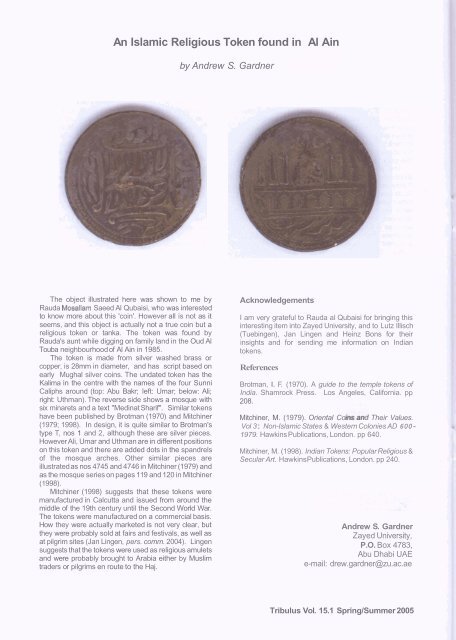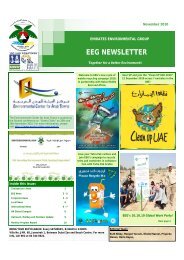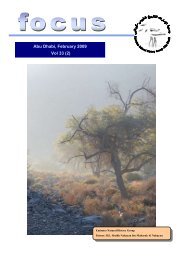Oman (Lepidoptera: Pieridae) - Al Ain Chapter, Emirates Natural ...
Oman (Lepidoptera: Pieridae) - Al Ain Chapter, Emirates Natural ...
Oman (Lepidoptera: Pieridae) - Al Ain Chapter, Emirates Natural ...
You also want an ePaper? Increase the reach of your titles
YUMPU automatically turns print PDFs into web optimized ePapers that Google loves.
An Islamic Religious Token found in <strong>Al</strong> <strong>Ain</strong><br />
The object illustrated here was shown to me by<br />
Rauda Mosallam Saeed <strong>Al</strong> Qubaisi, who was interested<br />
to know more about this 'coin'. However all is not as it<br />
seems, and this object is actually not a true coin but a<br />
religious token or tanka. The token was found by<br />
Rauda's aunt while digging on family land in the Oud <strong>Al</strong><br />
Touba neighbourhood of <strong>Al</strong> <strong>Ain</strong> in 1985.<br />
The token is made from silver washed brass or<br />
copper, is 28mm in diameter, and has script based on<br />
early Mughal silver coins. The undated token has the<br />
Kalima in the centre with the names of the four Sunni<br />
Caliphs around (top: Abu Bakr; left: Umar; below: <strong>Al</strong>i;<br />
right: Uthman). The reverse side shows a mosque with<br />
six minarets and a text "Medinat Sharif". Similar tokens<br />
have been published by Brotman (1970) and Mitchiner<br />
(1979; 1998). In design, it is quite similar to Brotman's<br />
type T, nos 1 and 2, although these are silver pieces.<br />
However <strong>Al</strong>i, Umar and Uthman are in different positions<br />
on this token and there are added dots in the spandrels<br />
of the mosque arches. Other similar pieces are<br />
illustrated as nos 4745 and 4746 in Mitchiner (1 979) and<br />
as the mosque series on pages 119 and 120 in Mitchiner<br />
(1 998).<br />
Mitchiner (1998) suggests that these tokens were<br />
manufactured in Calcutta and issued from around the<br />
middle of the 19th century until the Second World War.<br />
The tokens were manufactured on a commercial basis.<br />
How they were actually marketed is not very clear, but<br />
they were probably sold at fairs and festivals, as well as<br />
at pilgrim sites (Jan Lingen, pers. comm. 2004). Lingen<br />
suggests that the tokens were used as religious amulets<br />
and were probably brought to Arabia either by Muslim<br />
traders or pilgrims en route to the Haj.<br />
by Andrew S. Gardner<br />
Acknowledgements<br />
I am very grateful to Rauda al Qubaisi for bringing this<br />
interesting item into Zayed University, and to Lutz Illisch<br />
(Tuebingen), Jan Lingen and Heinz Bons for their<br />
insights and for sending me information on Indian<br />
tokens.<br />
References<br />
Brotman, I. F. (1970). A guide to the temple tokens of<br />
India. Shamrock Press. Los Angeles, California. pp<br />
208.<br />
Mitchiner, M. (1979). Oriental Coins an Their Values.<br />
Vol 3 : Non-Islamic States & Western Colonies AD 600-<br />
1979. Hawkins Publications, London. pp 640.<br />
Mitchiner, M. (1 998). Indian Tokens: Popular Religious &<br />
Secular Art. Hawkins Publications, London. pp 240.<br />
Andrew S. Gardner<br />
Zayed University,<br />
P.O. Box 4783,<br />
Abu Dhabi UAE<br />
e-mail: drew.gardner@zu.ac.ae<br />
Tribulus Vol. 15.1 Spring/Summer 2005




